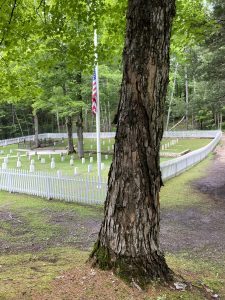For countless generations, Anishinaabek residents have gathered sap from sugar maple trees each spring, boiling it into pure maple sugar. Near the Straits of Mackinac, historical accounts show maple sugaring was especially common at nearby Bois Blanc Island and at L’Arbre Croche, along the Lake Michigan shore. It takes 40 gallons of sap to make one gallon of syrup, which can make about 8 pounds of sugar. Typically, granulated sugar was packed into containers (mokoks), fashioned of birch bark, sewn together with spruce roots. Maple treats were also packed into wooden molds and decorative bark containers, sold for the local tourist trade. Mind-boggling amounts of maple sugar were produced annually at the straits, with records of more than 200,000 pounds (100 tons) being shipped by Mackinac traders at in a single season.
As the month of April 2023 winds down, Michigan’s maple sugaring season has already come to a close. When maple buds start to open, sap turns cloudy and assumes a bitter taste. As temperatures remain above freezing both day and night, pressure also drops inside trees, causing sap to slow and taps to dry up completely. Historically at Mackinac, colder weather usually persisted later into spring. Most seasons, the straits would not be ice free until mid-April, when ship traffic could finally resume. In the woods, maple sugaring season would often last through April, or even into early May.


While most sugaring was done nearby, at least a few maples were tapped on Mackinac Island in the early 1880s. On April 28, 1883, Fort Mackinac’s post surgeon, Dr. William H. Corbusier, instructed his four young sons (along with those of Captain Edwin Sellers) in the age-old practice. Their mother, Fanny Dunbar Corbusier, later recorded the special memory. She wrote, “Father instructed the boys how to tap the sugar maple in the woods, collect the sap, boil it down over an open fire, and test it to learn when it was ready to crystalize into sugar. The pleasure derived by father and sons was very great. One day they tapped eleven trees and caught four gallons of sap.”
The perspective recorded by their 10-year-old son, Harold, was somewhat more candid. He wrote, “The Sellers boys and we went into the woods at the foot of the hill on the west side of Fort Holmes to gather maple sap. We ate our lunch out here. We taped eleven trees and brought home four galons of sap and would of had more but we wasted a great deal.” One can easily imagine the sticky adventure as eight boys, the oldest just 12 years of age, attempted to collect sap and perform the slow practice of transforming it into sugar. Today, large sugar maples still grow on the west side of Fort Holmes hill, not far from the Post Cemetery.


Less than one year later, on April 12, 1884, Captain Edwin Sellers was laid to rest under the shade of Mackinac’s maples. In early April, Fort Mackinac’s beloved commandant fell ill, suffering a sudden and severe bout of pneumonia. “We all loved him,” wrote Captain Charles Davis, “and there will ever remain in the hearts of his friends a recollection of his manly worth, earnest devotion to duty, fidelity in friendship and generous sympathies that will serve to keep his memory cherished so long as one remains.”
During your next visit to Mackinac, stop at the Post Cemetery and look for the final resting place of Edwin Sellers. Perhaps the maples growing nearby were tapped 140 years ago by eight rambunctious boys. Listen closely, and you just might hear faint echoes of sweet laughter amidst the rustle of sugar maple leaves.








